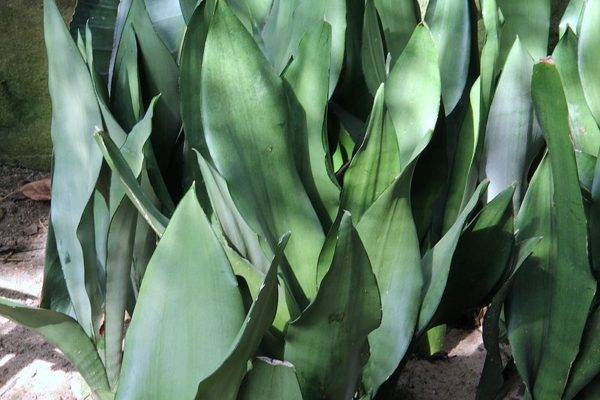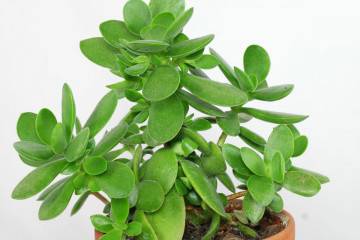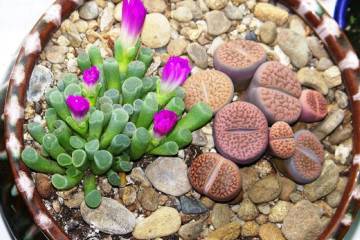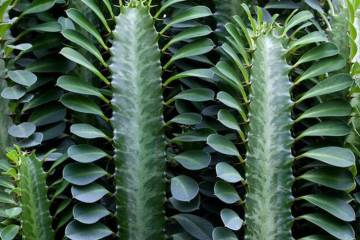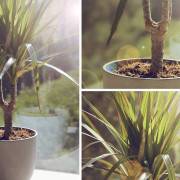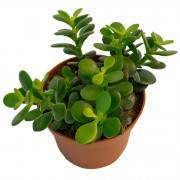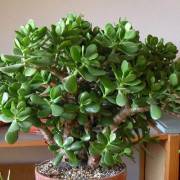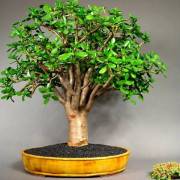Sansevieria - home care
Content:
Sansevieria is a common flower that does not require special care or special skills. If you take care of him properly, he pleases his owners with flowering, constantly cleans the room of accumulated harmful substances.
Description of sansevieria
Sansevieria is a flower that is a stemless evergreen that belongs to the Asparagus family. In the wild, it lives in the tropics and subtropics of Africa, is distinguished by upright long foliage of a variegated shade. It can reach a height of 1 m, it grows 3-4 leaves per year.
Common varieties
The sansevieria plant has many varieties, but the following varieties can most often be found in indoor conditions.
Cylinder is a plant with dark green cylindrical foliage; longitudinal grooves are located along the entire length of the leaf plate. Hard shoots emerge from the sinuses of the lower leaves, they are able to take root on their own. Flowers are located in racemose inflorescences.
Sansevieria Laurenti (Laurento) differs in xiphoid foliage 1-1.2 m long.The leaf plate is dark green, with longitudinal white stripes on it. Flowers with a greenish-white tint, strong aroma, they are collected in a brush.
There is also a large sansevieria. The rosette contains 3-4 fleshy leaves, the total length does not exceed 60 cm. The foliage is dark green with a red border and dark stripes located transversely. The flowers are white or with a slight greenish tinge, collected in a brush.
The varieties popular with flower growers also include:
- Futuru. A plant not exceeding 60 cm, with lanceolate foliage, a slight expansion of the leaf blade to the upper side and a yellow border around the edges;
- Compact up to 80 cm long. Bright green feathers are decorated with a yellow stripe running strictly in the center;
- Twistd Sister is distinguished by low rosettes, strong curl of leaves with a yellow border around the edges.
Features of home care
Choosing a sansevieria flower, home care will not be difficult even for beginners.
Temperature
In the house, the flower feels good at a temperature of 16-25 ° C. In summer, sansevieria does not need additional care, it easily tolerates the heat. In the winter season, it can survive a temperature drop of up to 10 ° C.
Lighting
The plant grows well both in direct sunlight and in diffused light. Preference is given to southwest or southeast windows. Under normal light, the flower develops large and strong leaves with an intense color.
Watering
The flower does not tolerate abundant moisture in the earth, which causes rotting of the roots. In the summer, it is enough to water once a week, during which time the soil in the pot should dry out almost completely. During watering, make sure that liquid does not accumulate in the outlet, especially in winter. Because of this, decay of the foliage may begin.
When leaving, the flower is watered a little more than usual and removed from the burning sun. Within a month, the plant will feel great without water.
Spraying
Drip wetting is not required for the plant. In some situations, spraying leads to rotting of the green part, after which it must be transplanted from bad soil into fresh one.
Humidity
Tropical plants prefer dry air. There will be no benefit from high humidity, rarely any of the succulents will start to hurt.
Priming
A suitable soil for sansevieria is a nutritious soil mixture purchased from a store or prepared on your own. To do this, take 1 part of leaf and sod soil, 2 parts - river sand. Drainage from expanded clay should occupy 1/3 of the pot.
Top dressing
Fertilizers are applied up to 2 times a month during intensive growth and development of the crop. Florists prefer to feed the flower with universal solutions intended for decorative deciduous plants.
In winter, fertilizers are not applied, despite the fact that the plant does not have a pronounced dormant period. Under favorable conditions, it develops all year round.
Pruning
Sick, dried, damaged parts of the flower are pruned. They are cut out in the area of the base; the plant is not watered for three days after the procedure.
When and how sansevieria blooms at home
Sansevieria blooms regularly, although the flowers are not distinguished by their beauty. They open in the evenings and close in the morning. All night long there is a spicy aroma in the apartment.
To stimulate a culture, it is enough to provide it with a period of rest. For a month, the pot should stand in a cool place, the amount of watering for this time is halved. After 30 days, it is transferred to the heat and watered according to the standard scheme.
How sansevieria reproduces
Reproduction of sansevieria is carried out in three ways:
- seeds. The plant rarely succeeds in propagating in this way due to the difficulty of buying seeds. Experienced growers get them from their plants - fruit pods. After collecting them, they are dried, the seed material is removed before planting. For disembarkation, use wide boxes covered with moist soil. After the procedure, the containers are wrapped in plastic wrap, sent to a warm place with good lighting. The first shoots are expected in a few months;
- rhizome. It is an easy and affordable way. An adult plant is divided into several outlets, then they are seated. The procedure is combined with a planned transplant;
- sheet. You can propagate it as a whole or as a separate part. Fragments of a sheet plate are placed in wet sand, covered with polyethylene. After 2 months, young shoots will appear, and the formed rosettes with 2-3 leaves are planted in separate boxes.
Transfer
At home, a sansevieria transplant is carried out every 2-3 years. The frequency depends on the rate at which the box is filled with the plant's root system.To prevent the flower from growing in width, choose containers of a smaller volume. Excess rosettes are removed with a sharp knife.
Ceramic pots for sansevieria are chosen, since the thin walls of plastic products are easily torn apart by a powerful root system.
Pests and diseases
The plant practically does not get sick, in most cases, problems are caused by improper care. Changes in the content of the flower are necessary when the following signs appear:
- dark spots on foliage. Formed when the sand is excessively wet at a low room temperature;
- yellowness. Too small capacity or lack of light;
- yellowing of the tips. They become lethargic and dry due to constantly wet soil, insufficient lighting, cold in the room;
- soft and flexible sheet plates. Pulling to the light source leads to overloads, they cannot support their own weight;
- foliage begins to curl. The problem arises due to the lack of water, rare wetting of the sand.
In other cases, an unpresentable species of succulents is associated with attacks of insect pests:
- pallor, yellowing and whitish spots on the foliage indicate a spider mite lesion. To save the plant, you need to wipe it with a damp cloth, then treat it with an insecticidal preparation. The appearance of the parasite can be prevented by regular humidification of the air;
- light spots on the outer surface of the plates and the larva on the seamy - the flower is attacked by thrips. The destruction of parasites is carried out with insecticides;
- curvature and yellowness of the peduncle, foliage is associated with hairy lice or mealybugs. A small lesion requires mechanical removal of the pests and the processing of the plates with a damp cloth. In case of mass destruction, insecticidal solutions are used;
- brownish spots with colonies of insects - scaly infestation. Treatment - treatment with insecticides 3 to 4 times a week.
A spectacular and unpretentious flower does not require regular pruning, complex and lengthy care procedures. It is enough to follow the recommendations for growing a succulent so that it can bloom and constantly purify the air of harmful elements.



